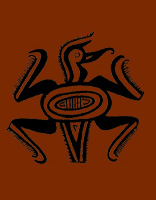Cosmos in Clay: Ceramics and Gold from Panama
The gold pieces and ceramics in this exhibit derive from the isthmus of Panama, primarily central Panama. Most pieces are examples of the flowering of Panamanian art between 500 and 1100 AD. Polychrome ceramics from this period are representative of the so-called Code and Veraguas regions of cultures with stylistic subdivisions into Conte polychrome (500-800 AD) and Macaracas polychrome (800- 1100 AD).

Panama was inhabited by small numbers of large-game hunting Paleoindians as early as 10,000 BC. By 5,000 BC hunting, gathering and fishing groups utilizing local resources were well established, and by 3,000 BC limited horticulture, probably of root crops, and production of simple, poorly fired ceramics had developed. Settled village life based on seed agriculture was established after 1,000 BC and a fully developed, intensive agricultural economy based on a diversity of cultivated plants was fully in place by 500 BC.
By 500 AD life in central Panama had become more complex. Status differences among families were accentuated and central Panamanian peoples became organized as typical rank societies or chiefdoms composed of two social sectors, aristocratic families and commoner families. Aristocrats held responsibility for political authority, religious rituals, and external relations, including raids and trade with elites of other polities. This hierarchical form of political and social organization persisted until the European conquest.
The high status of aristocrats is evidenced by the wealth interred with their remains in oval or rectangular tombs. Excavations of a number of graves, such as those from the Conte site, has revealed that a variety of gold ornaments adorned their persons and that their remains were placed on “floorings” composed to varying degree of stone slabs, turtle shells, the bodies of sacrificed retainers, bark cloth, and/or layers of elaborately decorated ceramic bowls. Tomb walls were also lined or encrusted with ceramics and ceramics were distributed around the edges and tops of the graves. Considered overall, ceramics appear to have been used as a kind of “fill” such that the remains of the deceased were virtually encased within a ceramic chamber. By analogy with beliefs from other tropical peoples we can say that at death aristocrats, destined to be born again in an afterlife as ancestors, were buried in a form of ceramic womb. Ultimately aristocrats, “reborn” as immortal ancestors, would be associated with the cosmological powers held responsible for life and especially the origins of life. The same theme of cosmological origins underlies particular designs on ceramic wares.
Panamanian ceramics exhibit a variety of forms and designs, and design motifs are often rendered in several colors. Understanding the use of color is, therefore, an important aspect of understanding Panamanian art. In the broadest sense the manner in which color is used in indigenous art expresses concepts about the nature of the cosmos. When color is applied in solid blocks, with firm borders, as in Panamanian art, the various blocks of color that, taken together, form a figure also reaffirm that the universe is an ordered and organized place composed of separate elements that fit together to form the whole. The particular use of several colors in a particular design may also indicate that the figure expresses several distinct “subthemes”.
The colors and color shades used in central Panamanian polychrome ceramics include black, red, light red, purple (possibly regarded as another shade of red), brown, and (especially characteristic of Veraguas wares) a dark orange. These colors are typically combined in sets involving black and one or two shades of red and purple, for example, light red, dark red or back and purple. When originally crafted the vessels and their polychrome designs were also coated with a shiny glaze. Contemporary indigenous peoples of Tropical America distinguish not only between separate colors per se but also between the relative brightness or brilliance and darkness or dullness of colors. Shiny colors are associated with the world of light and of the bright, reflective sun.
